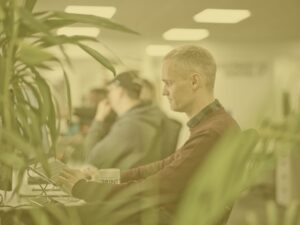
Blog
Can AI and Accessibility Lead to a More Sustainable, High Converting Website?
21st Jul, 2025
In an age of ethical consumerism and growing environmental awareness, businesses are increasingly being held accountable for the way they design and deliver their digital experiences.
However, sustainability in web design is not just about your digital carbon footprint or green hosting. It’s about creating and maintaining websites that are streamlined, inclusive, efficient, and optimised for both users and search engines.
By bringing together artificial intelligence, accessibility, and sustainable digital practices, marketers have an opportunity to build and manage websites that are not only better for the planet but also better for users and performance.
In particular, AI and accessibility play a powerful role in driving both conversion rate optimisation (CRO) and search engine optimisation (SEO).
Below, we explore how combining these three elements could help to future-proof your brand’s website and support your customers and your commercial goals.
Accessibility Is a CRO and SEO Advantage
Accessibility is often discussed as a compliance issue or moral obligation for a business, but its impact on digital marketing and conversion performance should not be overlooked.
Making a website accessible means ensuring that users with visual, auditory, motor, or cognitive impairments can navigate, understand, and interact with it easily.
In practice, this usually leads to cleaner design, clearer structure, and more focused content.
These improvements benefit all users, including those without disabilities, by reducing friction in the user journey. The result is often higher user engagement and fewer drop-offs.
This is clearly a win from a CRO perspective, as accessible websites can increase task completion rates and reduce bounce.
They remove barriers and friction points that can prevent users from converting, such as confusing forms, hard-to-read text, or inaccessible navigation.
From an SEO standpoint, accessibility aligns closely with how search engines evaluate quality.
For example, the use of semantic HTML, alt text for images, clear heading structures, and transcribed video content all help search engines understand and index your site more effectively.
AI Is Powering Smarter, Leaner, and Faster User Experiences
AI is rapidly transforming how our partners build, and how we optimise, websites.
When applied thoughtfully, it can support both SEO and CRO efforts while also reducing digital bloat and waste.
In CRO, AI can power advanced personalisation, predictive analytics, and A/B testing at scale.
This allows marketers to create user journeys that feel more relevant, reducing time-to-conversion and increasing the likelihood of engagement.
Tools that monitor on-site behaviour can identify drop-off points in real time and suggest design or content improvements.
On the SEO side, AI-driven content tools help ensure that your pages are aligned with user intent and structured for search visibility.
From suggesting internal links to identifying keyword gaps, AI can streamline optimisation tasks that once required hours of manual work.
AI can also play a role in reducing unnecessary page weight by automating tasks like image compression, lazy loading, and code clean-up. These improvements enhance site speed, which is a known ranking factor and a key contributor to improved user experience.
Sustainable Websites Perform Better in Search and Sales
Digital sustainability is about creating websites that are efficient, lightweight, and built to minimise their online and offline environmental impact. Interestingly, these same principles also support better SEO and CRO outcomes.
Fast-loading pages not only reduce server load and energy use but also improve dwell time and conversion rates.
Google’s Core Web Vitals framework prioritises performance metrics such as Largest Contentful Paint (LCP) and Cumulative Layout Shift (CLS), which are directly tied to how smoothly and quickly users can engage with your site.
Cleaner code, smaller files, and fewer unnecessary plugins reduce the risk of performance issues and make it easier for search engines to crawl and index your content.
The benefits are twofold: your website is better for the planet and more likely to appear in relevant search results.
Where AI, Accessibility, and Sustainability Combine
When digital accessibility and online sustainability are supported by intelligent AI tools, users can experience a more efficient and effective digital experience.
For example, voice navigation, live transcription, and alt text generation tools all use AI to expand access to users without increasing manual workload for your team.
At the same time, optimising web content and design for accessibility often leads to simpler, faster-loading pages. This benefits users on older devices or slow internet connections, reducing exclusion and improving equity across your user base.
Together, these approaches create digital journeys that are inclusive, lightweight, and conversion-focused.
Practical Steps to Optimise for People, Planet, and Performance
To bring all this together, we’ve got a few key takeaways for digital marketers.
Firstly, you could use AI tools to audit your accessibility and performance on a regular basis.
Also, prioritise mobile-first design and fast load times. Reduce reliance on unnecessary third-party scripts, and ensure your content is clear, structured, and relevant to the audience’s intent.
For SEO, that means building semantically rich, easily crawlable pages with meaningful and highly relevant content, and strong internal linking. For CRO, it means creating accessible forms, prominent and engaging CTAs, and frictionless navigation that supports all users.
The tools and techniques that support these goals are widely available and increasingly automated.
The real shift is strategic: making performance, inclusion, and sustainability part of how you measure success.
Future-Proofing Your Website
Bringing together AI, accessibility, and sustainability can create websites that are not only kinder to the environment and more inclusive for all users, but also stronger in performance for your brand.
For marketers focused on SEO and CRO, this intersection is a sweet spot.
These aren’t competing marketing priorities; they’re complementary to each other. A fast, accessible website supported by smart AI is more likely to rank well, convert users, and build long-term trust.
Investing in this approach now means building a digital presence that’s ready for the next generation of users, expectations, and technologies.
If you’re interested in finding out more about CRO, SEO, digital sustainability, accessibility audits, or a mixture of all of these – simply get in touch and we can organise a chat.







